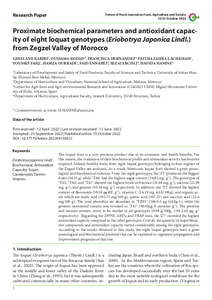| dc.date.accessioned | 2022-12-14T14:17:13Z | |
| dc.date.available | 2022-12-14T14:17:13Z | |
| dc.date.issued | 2022-10-15 | |
| dc.identifier | doi:10.17170/kobra-202204136021 | |
| dc.identifier.uri | http://hdl.handle.net/123456789/14292 | |
| dc.language.iso | eng | |
| dc.rights | Namensnennung 4.0 International | * |
| dc.rights.uri | http://creativecommons.org/licenses/by/4.0/ | * |
| dc.subject | biochemical | eng |
| dc.subject | antioxidant capacity | eng |
| dc.subject | sugar | eng |
| dc.subject | carotenoids | eng |
| dc.subject | tannin | eng |
| dc.subject | vitamin | eng |
| dc.subject | Eriobotrya japonica Lindl | eng |
| dc.subject.ddc | 570 | |
| dc.subject.ddc | 580 | |
| dc.title | Proximate biochemical parameters and antioxidant capacity of eight loquat genotypes (Eriobotrya Japonica Lindl.) from Zegzel Valley of Morocco | eng |
| dc.type | Aufsatz | |
| dcterms.abstract | The loquat fruit is considered as a very precious product due to its economic and health benefits. For this reason, the evaluation of their biochemical profile and antioxidant activity has become required. Indeed, healthy fruits are collected from eight loquat genotypes belonging to four regions of the Zegzel Valley. As a results, loquat fruit analysed showed a great pomological and biochemical richness. From the eight genotypes, the ‘Z1’ produced the biggest fruits (54.55 g) while ‘TA6’ had the highest sugar content (54.85 mg. g-¹). The genotypes of ‘TA5’, ‘TA6’ and ‘TA7’ showed the highest levels of fructose (31.64 mg. g-¹), sucrose (21.09 mg. g-1) and glucose (10.34 mg. g-¹) respectively. In addition, the ‘T2’ showed the highest content of flavonoids (59.58 µg RE. g-¹), vitamin C (14.19 mg AAE/100g) and organic acids which are malic acid (193.75 mg/100 g), quininic acid (107.25) and succinic acid (12.6 mg/100 g). For the total phenolics are abundant in ‘TZN1’ (186.0.5 µg GAEg-¹), while the greatest carotenoid content was revealed in ‘TA7’ (90.65µg ß-carotene g-¹). Concerning proteins content, the highest amount observed for ‘Z7’ (0.98 g/100g), whereas the tannin content appeared similar in all genotypes (2.94-2.61 µg. g-¹). Regarding the DPPH, ABTS and FRAP tests, the ‘Z7’ recorded the highest antioxidant capacity compared to the other genotypes. Overall, the quantity of major bioactive compounds and antioxidant capacity varied considerably among the eight genotypes. According to the results obtained in this study, the eight loquat genotypes have a great pomological and biochemical potential that can be exploited in vegetative propagation and improvement programs of this tree. | eng |
| dcterms.accessRights | open access | |
| dcterms.creator | Kabiri, Ghizlane | |
| dcterms.creator | Kodad, Oussama | |
| dcterms.creator | Hernandez, Francisca | |
| dcterms.creator | Lachkham, Fatima Zahra | |
| dcterms.creator | Faiq, Youssef | |
| dcterms.creator | Ourradi, Hamza | |
| dcterms.creator | Ennahli, Said | |
| dcterms.creator | Ercisli, Sezai | |
| dcterms.creator | Hanine, Hafida | |
| dcterms.extent | 12 Seiten | |
| dc.subject.swd | Marokko | ger |
| dc.subject.swd | Wollmispel | ger |
| dc.subject.swd | Carotinoide | ger |
| dc.subject.swd | Genotyp | ger |
| dc.subject.swd | Gesunde Ernährung | ger |
| dc.title.subtitle | Evaluation of biochemical parameters and antioxidant capacity of eight loquat genotypes (Eriobotrya Japonica Lindl.) of Morocco | eng |
| dc.type.version | publishedVersion | |
| dcterms.source.identifier | eissn:2197-411X | |
| dcterms.source.issue | No. 5 | |
| dcterms.source.journal | Future of Food: Journal on Food, Agriculture & Society | eng |
| dcterms.source.volume | Vol. 10 | |
| kup.iskup | false | |
| dcterms.source.articlenumber | 589 | |


